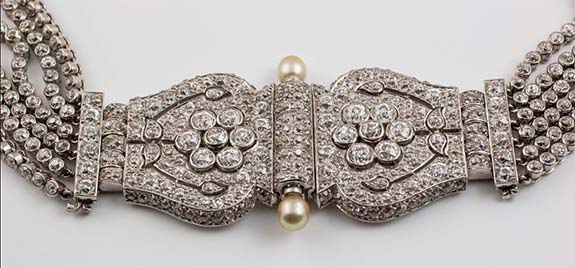June 11th, 2019
Natural pearls are among the rarest of all gems. In fact, experts believe the odds of opening a random oyster in the wild and finding a natural pearl is 1 in 100,000. What's more, if someone was lucky enough to amass a small collection of natural pearls, there's hardly a chance that they'd match in terms of size, shape, color and luster.

These factors underscore why the Smithsonian's "Dunn Pearl Necklace" is so incredible.
Designed by Cartier in the 1920s and donated to the Smithsonian by Mrs. Arthur Wallace Dunn in 1977, the Dunn Pearl Necklace is adorned with 339 natural pearls, ranging in size from 3.3mm to 7.8mm.

Not only is that an astonishing number of natural pearls, but the five rows of cream-colored gems are very well matched. It's hard to fathom how many oysters had to be processed in order to yield the natural pearls that make up this necklace.
In a Smithsonian review of the piece, the author called the Dunn Pearl Necklace a "treasure from the vault" at the National Museum of Natural History.

In additional to the extraordinary array of pearls, the necklace includes an Art Deco-era platinum clasp set with 428 old-mine diamonds. The diamond total weight of the piece is approximately 16 carats.
Mrs. Arthur Wallace Dunn was the wife of a prominent Washington, DC-based journalist and author, who hobnobbed with presidents Warren G. Harding, Theodore Roosevelt and Woodrow Wilson.
June's official gemstone — the pearl — is unique among all of the gems because it is the only one formed entirely within a living creature. Natural pearls occur when an irritant enters the oyster's shell. To protect itself from the foreign body, the mollusk secretes layers of nacre, which, over time, become a lustrous pearl. To make a cultured pearl, a shell bead is surgically implanted into the mollusk to induce nacre production.
Credits: Dunn Pearl Necklace by Donald E. Hurlbert/Smithsonian. Clasp closeup by Ken Larsen/Smithsonian.

These factors underscore why the Smithsonian's "Dunn Pearl Necklace" is so incredible.
Designed by Cartier in the 1920s and donated to the Smithsonian by Mrs. Arthur Wallace Dunn in 1977, the Dunn Pearl Necklace is adorned with 339 natural pearls, ranging in size from 3.3mm to 7.8mm.

Not only is that an astonishing number of natural pearls, but the five rows of cream-colored gems are very well matched. It's hard to fathom how many oysters had to be processed in order to yield the natural pearls that make up this necklace.
In a Smithsonian review of the piece, the author called the Dunn Pearl Necklace a "treasure from the vault" at the National Museum of Natural History.

In additional to the extraordinary array of pearls, the necklace includes an Art Deco-era platinum clasp set with 428 old-mine diamonds. The diamond total weight of the piece is approximately 16 carats.
Mrs. Arthur Wallace Dunn was the wife of a prominent Washington, DC-based journalist and author, who hobnobbed with presidents Warren G. Harding, Theodore Roosevelt and Woodrow Wilson.
June's official gemstone — the pearl — is unique among all of the gems because it is the only one formed entirely within a living creature. Natural pearls occur when an irritant enters the oyster's shell. To protect itself from the foreign body, the mollusk secretes layers of nacre, which, over time, become a lustrous pearl. To make a cultured pearl, a shell bead is surgically implanted into the mollusk to induce nacre production.
Credits: Dunn Pearl Necklace by Donald E. Hurlbert/Smithsonian. Clasp closeup by Ken Larsen/Smithsonian.



